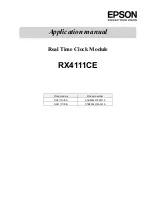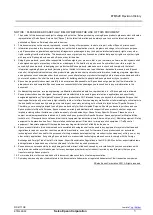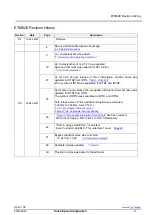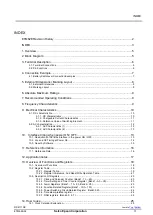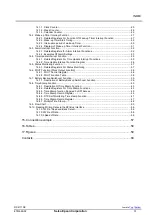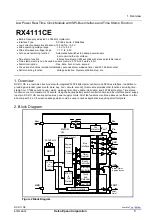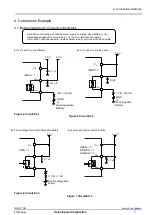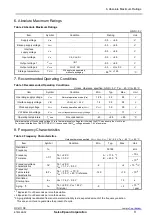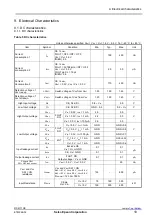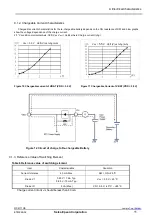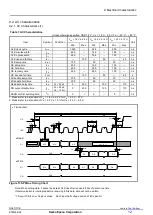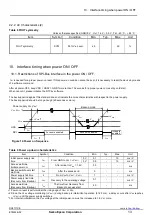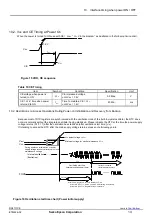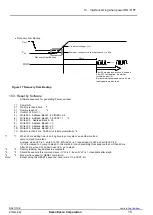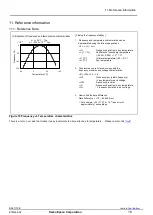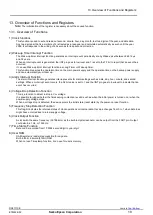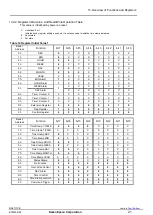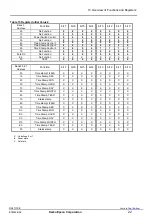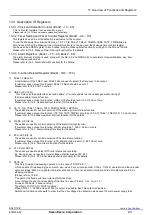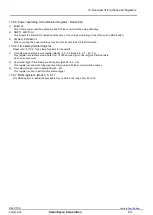
6. Absolute Maximum Ratings
RX4111CE
Jump to
ETM62E-02
Seiko Epson Corporation
9
6. Absolute Maximum Ratings
Table 2 Absolute Maximum Ratings
GND
=
0
V
Item
Symbol
Condition
Rating
Unit
Supply voltage
V
DD
0.3
+6.5
V
Backup supply voltage
V
BAT
0.3
+6.5
V
Interface
supply voltage
V
IO
0.3
+6.5
V
Input voltage
V
IN
CE, CLK, DI
0.3
+6.5
V
Output voltage 1
V
OUT1
/INT
0.3
+6.5
V
Output voltage 2
V
OUT2
FOUT, DO
-0.3
V
IO
+0.3
V
Storage temperature
T
STG
When stored separately,
without packaging
55 to +125
C
7. Recommended Operating Conditions
Table 3 Recommended Operating Conditions
Unless otherwise specified, GND
=
0
V
,
Ta
=
40
C
to
+85
C
Item
Symbol
Condition
Min.
Typ.
Max.
Unit
Operating supply voltage
V
DD
Normal operation mode (V
DD
)
1.25
3.0
5.5
V
Interface supply voltage
VIO
VDD=1.6V
5.5V
1.6
3.0
5.5
V
Clock supply voltage
V
CLK
Backup operation mode (V
BAT
)
V
VLF
3.0
5.5
V
VLF detection voltage
V
VLF
Low voltage detection of supply Voltage.
-
-
1.1
V
Operating temperature
T_use
No condensation
40
+25
+85
C
Minimum value of Clock supply voltage V
CLK
is the lower supply voltage limit till which the RTC can assure the clock to run.
For proper initialization of the RTC RX4111 it is necessary that V
DD
voltage exceeds 1.6V at power up.
8. Frequency Characteristics
Table 4 Frequency Characteristics
Unless otherwise specified, V
BAT
= V
DD
= V
IO
= 1.6V
5.5 V, Ta = -40
C
+85
C
Item
Symbol
Condition
Min.
Typ.
Max.
Unit
Oscillation
Frequency
fo
32.768
kHz
Frequency
Tolerance
f
/
f
Ta
=
+25
C
V
DD
=
3.0
V
A :
11.5 *1
B :
23.0 *2
10
6
10
6
Frequency/voltage
characteristics
f/V
Ta
=
+25
C
V
DD
=
1.1
V
5.5
V
2
+2
10
6
/
V
Frequency/
Temperature
characteristics
fo-T
C
Ta
=
20
C
+70
C
V
DD
=
3.0
V;
+25
C reference
120
+10
10
6
Oscillation
Start-up time
t
STA
V
DD
=
1.6
V
5.5
V
1.0
s
Aging *3
fa
Ta
=
+25
C
,
V
DD
=
3.0
V
;
First year
5
+5
10
6
/
year
1 Equivalent to
30 seconds per month deviation.
2 Equivalent to
60 seconds per month deviation.
*3 Aging stability is estimated from environmental reliability tests; expected amount of the frequency variation.
This does not intend to guarantee the product-life cycle.

